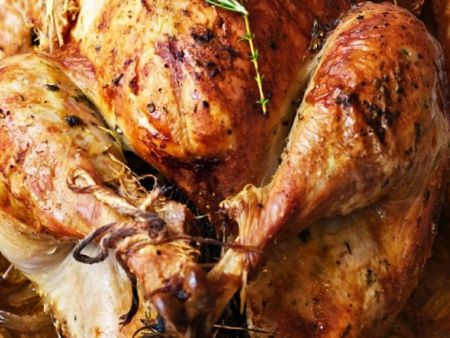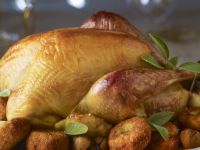How to Roast a Turkey
Roasting is easy. It's also a marvel of cooking science. Put a plump raw turkey into a hot oven and what emerges is something else entirely: A glistening, golden brown turkey that's the centerpiece at any Thanksgiving table. The oven heat does most of the work, and you'll have a couple hours of hands-off time while the turkey is roasting to tend to the rest of the meal.
Roasting Basics
You'll find countless variations on the roasted-turkey theme, some more complicated than others, but at their essence these recipes are based on the essential elements of temperature and time. This is especially true if you start with a good-quality turkey, and if you appreciate the innate flavor of the bird (particularly if cooking a heritage turkey). The same method works no matter what size turkey you are cooking, and whether it has been brined and/or stuffed (with a few tweaks here and there). For novices, this classic preparation is an excellent introduction to turkey roasting, but even experts might appreciate the back-to-basics approach (and devote all that extra time and energy on the rest of the Thanksgiving menu).
A few tips before you get started
- Always remove the turkey from the refrigerator about 30 minutes before cooking, and immediately remove turkey from its packaging. This will allow it to warm up a bit and dry out the surface. Remove the giblets and neck and reserve for making stock and/or gravy, if desired. Also, many experts suggest removing any pop-up thermometers and rely on an instant-read thermometer instead.
- Food safety guidelines stipulate a minimum oven temperature of 325 degrees, but you can opt to roast the turkey at higher temperatures. Just be sure not to cook at too high a temperature, or the bird will not cook evenly. What you want is somewhere between 325 and 425 degrees.
- You can find cooking time charts for roasting turkey at different oven temperatures, but the only way to know for sure whether your turkey is done is to measure the internal temperature with an instant-read thermometer, an inexpensive tool that's available in analog or digital models. But to help you plan how much time it will take to cook the turkey, the rule of thumb is 13 minutes per pound, or 3 1/2 hours for a 16-pound bird.
- Bacteria is fully killed at 165 degrees, and for this reason the USDA recommends cooking turkey to an internal temperature of 165 degrees before removing it from the oven. Because the temperature will continue to rise outside the oven, this means that turkey will reach 180 degrees after resting for 20 minutes. To keep the turkey from overcooking, many cooks prefer to remove the turkey once it reaches 150 degrees so the temperature will reach the required 165 degrees after resting.
Basic method for roasting a turkey
Follow this method for any size turkey that has been brined or not, and stuffed or not. Thaw a frozen turkey completely before cooking.
Tools
- kitchen twine: for tying the legs
- roasting pan with a wire rack: a heavier pan will not buckle under the weight of the bird and also when making gravy on the stove top; a wire rack or V rack is needed to lift the turkey off the pan
- turkey baster or basting brush: helpful if basting the turkey during cooking (a large ladle also works)
- instant-read thermometer: a must for determining whether the turkey (and stuffing) has cooked to the proper internal temperature; do not ever rely on the pop-up thermometers that come with conventional turkeys, or at least have a backup in case that one doesn't work (a common enough occurence)
Ingredients
- 1 whole turkey (fully thawed if frozen)
- salt and freshly ground black pepper
- softened or melted butter, for brushing (optional)
- olive oil, for brushing (optional)
- stuffing (optional)
- fresh herbs and aromatics (optional)
Preparation
- Let the turkey sit at room temperature while preheating the oven, with a rack in lower third. You'll most likely need to remove upper racks to allow a larger turkey to fit comfortably.
- Pat turkey dry with paper towels. Season turkey inside and out with salt and pepper. (Skip this step if you have brined the turkey or are using a kosher turkey.)
- Brush or rub softened or melted butter over entire surface of the turkey; some cooks like to loosen the skin first and spread the butter underneath. For a crispier, darker skin, use olive oil instead of butter; for the crispiest skin, don't rub it with anything.
- If you are stuffing the turkey, spoon that into the cavity; otherwise tuck some fresh herb sprigs, such as thyme, sage, parsley, and/or marjoram, inside cavity along with garlic, shallots, or other aromatics, as desired. Scatter more fresh herbs over top of turkey, as desired.
- Tuck the wing tips underneath the turkey and tie the legs together with kitchen twine. Or don't: Some cooks find that not tying the legs helps the turkey cook more evenly.
- Place turkey, breast side down, in a roasting pan fitted with a rack and add aromatics such as onion wedges, shallots or garlic heads or cloves around pan. Pour in enough liquid, such as broth, wine or a combination (about 2 cups) to cover bottom of pan.
- Roast until the meat is at the proper temperature on an instant-read thermometer. Baste turkey periodically with pan juices, and add more liquid to pan as needed to prevent the bottom from scorching. If making a pan gravy, you may prefer to skip basting and save the juices for that; also, basting can cause the surface to become streaky during cooking. For approximate cooking times per weight, see the USDA Turkey Roasting Chart. Note: those times are based on an oven temperature of 325 degrees; actual cooking times will be reduced for higher temperatures.
- Remove pan from the oven and transfer the turkey to a carving board. Let rest at least 20 minutes before carving.
To make a pan gravy
Don't let all those flavorful pan drippings go to waste; use them--and the pan itself--to make a delicious gravy while the turkey is resting.
Tools
- whisk
- wooden spoon
- fine sieve (optional)
Ingredients
- reserved pan drippings
- 1/4 cup all-purpose flour
- 1/2 cup dry white wine, sherry or port
- 5 to 6 cups turkey or chicken stock
- salt and freshly ground black pepper
Preparation
- Pour off all but 1/4 cup pan drippings from roasting pan and place over medium heat, using two burners if necessary.
- Sprinkle flour over drippings and cook, whisking constantly, until the roux is golden, about 10 minutes.
- Pour in wine while whisking and cook, whisking, until evaporated.
- Gradually add stock while stirring, and cook, stirring, until thickened, about 10 minutes.
- Strain stock if desired. Season with salt and pepper and serve in a gravy boat.
More recipes
{{amazon_product asin="B003L15PM8 " view_mode="small" product_text="Calphalon Tri-Ply Stainless Steel 14-Inch Roaster with Rack and Lifters" button_type="button1" inline_text="Calphalon Tri-Ply Stainless Steel Roaster"}}
{{amazon_product asin="B000079XWC " view_mode="small" product_text="OXO Good Grips Turkey Baster" button_type="button1" inline_text="OXO Good Grips Turkey Baster"}}
{{amazon_product asin="B00009WE45 " view_mode="small" product_text="Taylor Precision Products Commercial Digital Thermometer" button_type="button1" inline_text="Taylor Precision Products Commercial Digital Thermometer"}}






















